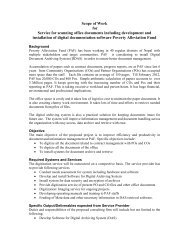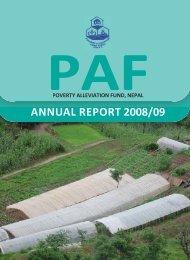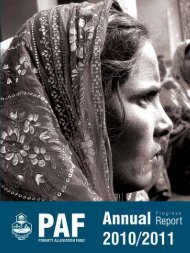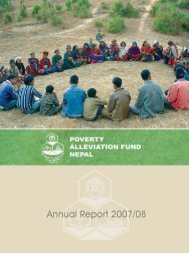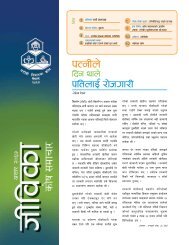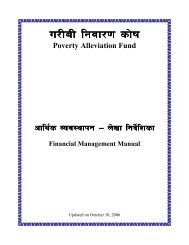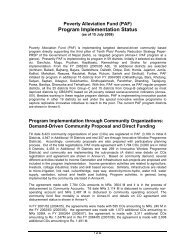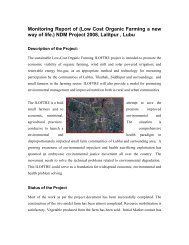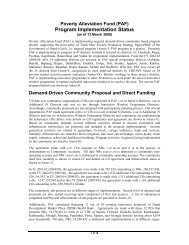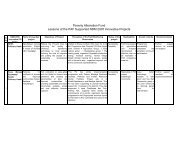Fiscal year 2010/11 - Poverty Alleviation Fund, Nepal
Fiscal year 2010/11 - Poverty Alleviation Fund, Nepal
Fiscal year 2010/11 - Poverty Alleviation Fund, Nepal
Create successful ePaper yourself
Turn your PDF publications into a flip-book with our unique Google optimized e-Paper software.
transport logistics, financing, and quality control. A capacity building<br />
agency would be contracted by PAF to work with community groups<br />
to identify needs, develop capacity-building plans and procure<br />
relevant technical assistance.<br />
(iv) Support to Rural and Community Finance: There is ample<br />
evidence that the vast majority of PAF beneficiaries do not have<br />
access to rural financial services, including microfinance lending.<br />
With a view to the longer-term sustainability and growth of the<br />
community Income Generating Activities (IGAs) and enterprises,<br />
PAF is supporting training for community-managed finance in order<br />
to strengthen institutions and encourage eventual access to broader<br />
financial services for livelihood support. To achieve this objective,<br />
this sub-component would finance mapping and monitoring<br />
of those emergent groups revolving their PAF grant funds and<br />
mobilizing savings; provide training and capacity building support to<br />
strengthen these activities; explore linkages to financial institutions<br />
and relevant partners; and support PAF’s articulation of a longer<br />
term vision or ‘graduation strategy’ for viable community institutions<br />
and enterprises.<br />
(v) Information, Monitoring and Evaluation: This subcomponent<br />
include: (a) dissemination of information about the<br />
project and other public sector programmes; (b) support for<br />
PAF’s management information system (MIS), which will need<br />
to be expanded to accommodate the scaled-up programme; (c)<br />
structured monitoring activities, including field visits to assess<br />
progress; (d) regular beneficiary assessments, including qualitative<br />
field work; and (e) follow-on impact assessment surveys to refine<br />
and monitor against the project<br />
Institutional and<br />
implementation arrangements<br />
At the national level, overall project management responsibility is with<br />
the PAF Board, chaired by the Prime Minister. The Vice Chairman<br />
functions as a full time executive of PAF, and the Board includes ten other<br />
Members. The Executive Director of PAF serves the Secretary of the<br />
Board. The ex-officio members are the Secretary of the National Planning<br />
Commission, the Chairpersons of the Federation of District Development<br />
Committee, the Village Development Committee, the National Women’s<br />
Commission and National Dalit Commission. Other appointed members<br />
are five prominent professional persons, including a woman, who have<br />
contributed to poverty alleviation in <strong>Nepal</strong>. PAF has a lean structure<br />
with a limited number of staff who have been recruited on fixed term<br />
contracts on a competitive basis, and a number of consultants and/or<br />
NGOs who are retained to support operations as needed.<br />
At the regional level, PAF is seeking to establish offices in those locations<br />
where the volume of work requires a presence, but keeps its own staff<br />
to a minimum. PAF works through POs which it recruits competitively,<br />
for purposes of social mobilization and capacity building at the<br />
community level. These POs disseminate information about the project,<br />
mobilize community groups, work with them and build their capacity<br />
to develop and manage sub-project proposals, and monitor the quality<br />
of participation. POs can be NGOs; community based organizations,<br />
or VDCs/DDCs, provided they meet PAF eligibility criteria. POs are<br />
required to appoint community facilitators in each target village, who<br />
must be trusted by and selected in consultation with the communities,<br />
with attention to PAF’s aim of reaching excluded groups. POs also liaise<br />
with local bodies to ensure that proposed infrastructure sub-projects<br />
are consistent with VDC/DDC plans and priorities. While POs may be<br />
entrusted by community groups to submit final sub-project proposals<br />
to PAF, once approved, grant funds flow directly to communities and not<br />
through POs.<br />
At the community level, PAF supports two types of sub-projects: (i) smallscale<br />
village infrastructure and services, and (ii) income generation. The<br />
same basic rules apply: sub-project proposals are identified by groups<br />
of poor people (which could include members of a village or several<br />
villages) who come together as community groups/organizations (COs);<br />
decisions regarding sub-projects are participatory and inclusive, and this<br />
is carefully monitored; the community groups make cash contributions;<br />
there are ceilings on the investment per household and on the size of<br />
each sub-project; and funds for implementation of sub-projects and<br />
technical assistance are deposited in community bank accounts.<br />
The village-level project cycle comprises: (a) community mobilization;<br />
(b) sub-project preparation including development of an operations<br />
and maintenance plan; (c) appraisal; (d) approval by the PAF Technical<br />
Appraisal Committee (TAC) and (e) implementation. Where local<br />
governments are operational, the DDCs and the VDCs also need to<br />
endorse infrastructure sub-projects. Final sub-project proposals are<br />
appraised by PAF staff and approved by the Board, although approval<br />
authority can be delegated to Portfolio Manager.<br />
Links with Local Governments<br />
PAF’s institutional arrangements at the local level is linked with<br />
government local bodies in the following way: (i) there is a dedicated<br />
component on capacity building for local bodies (ii) DDC/VDCs can be<br />
POs; (iii) all infrastructure sub-projects that are going to be financed<br />
through PAF have to be incorporated in VDC and the DDC annual plans;<br />
and (iv) for larger infrastructure demands from communities, VDCs<br />
and DDCs can co-finance any investment as long as PAF rules and<br />
criteria are met.<br />
ANNUAL PROGRESS REPORT (<strong>2010</strong>/20<strong>11</strong>) 3




